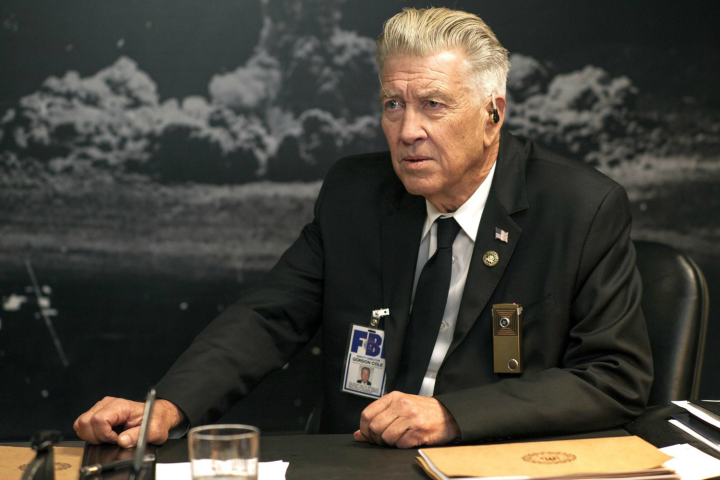
The episode also shows a refreshing level of competence from the law enforcement characters, who work to piece together clues with remarkable haste. Cooper’s former FBI comrades, Gordon Cole and Albert Rosenfield, have Cooper’s doppelgänger in custody. While they don’t know his exact nature, they suspect something is off from the way the evil Cooper talks; the first time they interrogated him he spoke one word of dialogue backwards, saying “It’s yrev, very good to see you again, old friend.”
Meanwhile in Twin Peaks, Deputy Chief Hawk has found missing pages of Laura Palmer’s diary, which mention that “the good Dale” is trapped in the Black Lodge. These separate investigations are leading both teams of investigators to the same conclusion: Someone has taken Dale Cooper’s identity.
Identity crisis
The most noteworthy moments of Part 7 — at least, those that didn’t involve a broom — concern the two Coopers. Both the amnesiac insurance agent Dougie Jones and the evil Cooper doppelgänger make moves that seem to set them on a path toward a confrontation.
Dual identities are a common motif in David Lynch’s works. Many of his films feature actors playing multiple roles (which may or may not be linked), or different actors playing the same character. Often, these characters are shown through a Hitchcockian lens of blonde and brunette women; the two leads of Mulholland Drive, Naomi Watts and Laura Elena Harring, are good examples, as is Patricia Arquette, who plays both blonde and brunette characters in Lost Highway. The technique is not limited to women, either; Bill Pullman’s character in Lost Highway morphs into one played by Balthazar Getty.
Into this tradition steps Kyle MacLachlan, playing two or more variations on Agent Dale Cooper. One of the most intriguing reasons to employ dual identities, other than to provide an acting showcase for MacLachlan, is that it allows Twin Peaks to perform its own spin on another Hitchcock trope: The man falsely accused.

While Dale Cooper languished in the Black Lodge for 25 years, his doppelgänger has been committing all manner of crimes using his name and face. Cooper’s journey isn’t just a return to the physical world, it is a chance to reclaim the role he once held and the reputation that has decayed in his absence.
A woman from the past
The prolonged stint as Dougie Jones gives other characters a chance to interact with the doppelgänger, and these interactions have been some of the show’s finest moments — both because MacLachlan is shockingly sinister in the role, and because we see how characters like Gordon Cole and Diane (Laura Dern) are able to instantly recognize that something is off.
Diane’s face-off with the doppelgänger is brief, but it packs volumes into a few minutes of sparse dialogue. They allude to the last time they saw each other, at Diane’s house.
Diane: Do you remember that night?
Cooper: I’ll always remember that night.
Diane: Same for me. I’ll never forget it.
The ambiguity leaves room for interpretation, aided by Diane’s murky role in Cooper’s life. In the original series she was entirely unseen, a character Cooper speaks to as he records his case files. The mystery surrounding their relationship adds to the drama of the scene. Diane speaks her lines with smoldering anger, and that emotional undercurrent suggests a lot. Was Diane’s last meeting with the actual Cooper, in which case the doppelgänger is simply trying to perform the role of her long lost partner? Or did that night occur after Cooper became trapped in the Black Lodge? If that’s the case, did something terrible transpire that night? The show does not provide an answer as of yet, but the implications are frightening.

Elsewhere, glimmers of Agent Cooper shine through in Dougie Jones. He continues to exhibit a childlike fascination with objects from his old life, reaching out for the badge of a detective who comes to question him. A more impressive display comes when Ike Stadtler, the icepick-wielding assassin from the previous episode, ambushes Dougie and his wife as they are leaving Dougie’s office. Ike runs at Dougie with a gun, and Dougie, in a movement one character compares to a cobra, grabs the gun and karate chops him in the throat. In the most surprising moment, the creature from the Black Lodge known as The Arm appears, still in the form of a fleshy tree, urging Cooper to squeeze his assailant’s hand off.
It’s an intense moment, and one with some important consequences. It shows that Cooper can, at a moment’s notice, draw on his past training, a sign that his old identity is ever closer to resurfacing. The scene also sets up a signal for other characters that Cooper is here; the attack took place in public, and a news crew showed up to cover it. It seems inevitable that someone from Cooper’s life will catch wind of the story.
With the evil Cooper having escaped from prison — he threatens the warden with the release of some sensitive info, and promises to vanish from the warden’s life if provided with a getaway car — and the FBI putting together clues that the doppelgänger is not really Agent Cooper, a confrontation looms. As the spirits of the Black Lodge implied before sending Cooper back to the physical world, he and his doppelgänger cannot coexist.
- ‘Twin Peaks’ revival ‘Part 6’ explained
- ‘Twin Peaks’ revival ‘Part 5’ explained
- Twin Peaks revival ‘Parts 3 and 4’ explained


